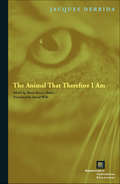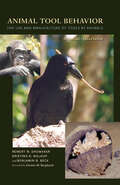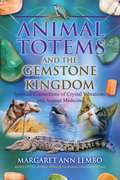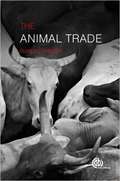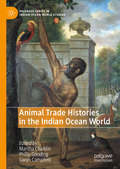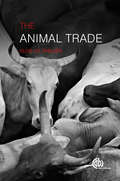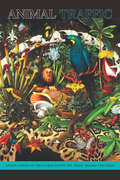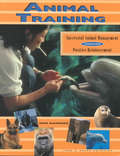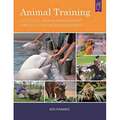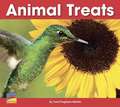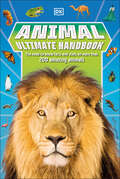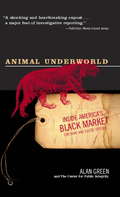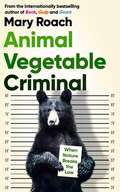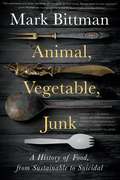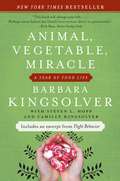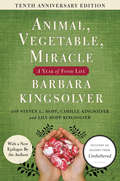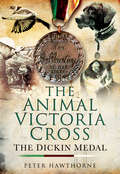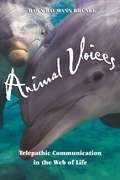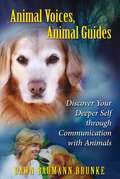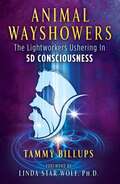- Table View
- List View
Animal Teeth and Human Tools
by Christy G. Turner II Nicolai D. Ovodov Olga V. Pavlova Christy G. Turner II Nicolai D. OvodovThe culmination of more than a decade of fieldwork and related study, this unique book uses analyses of perimortem taphonomy in Ice Age Siberia to propose a new hypothesis for the peopling of the New World. The authors present evidence based on examinations of more than 9000 pieces of human and carnivore bone from 30 late Pleistocene archaeological and palaeontological sites, including cave and open locations, which span more than 2000 miles from the Ob River in the West to the Sea of Japan in the East. The observed bone damage signatures suggest that the conventional prehistory of Siberia needs revision and, in particular, that cave hyenas had a significant influence on the lives of Ice Age Siberians. The findings are supported by more than 250 photographs, which illustrate the bone damage described and provide a valuable insight into the context and landscape of the fieldwork for those unfamiliar with Siberia.
The Animal That Therefore I Am (Perspectives in Continental Philosophy)
by Jacques Derrida David Wills Marie-Louise MalletThe Animal That Therefore I Am is the long-awaited translation of the complete text of Jacques Derrida’s ten-hour address to the 1997 Cérisy conference entitled “The Autobiographical Animal,” the third of four such colloquia on his work. The book was assembled posthumously on the basis of two published sections, one written and recorded session, and one informal recorded session. The book is at once an affectionate look back over the multiple roles played by animals in Derrida’s work and a profound philosophical investigation and critique of the relegation of animal life that takes place as a result of the distinction—dating from Descartes—between man as thinking animal and every other living species. That starts with the very fact of the line of separation drawn between the human and the millions of other species that are reduced to a single “the animal.” Derrida finds that distinction, or versions of it, surfacing in thinkers as far apart as Descartes, Kant, Heidegger, Lacan, and Levinas, and he dedicates extended analyses to the question in the work of each of them. The book’s autobiographical theme intersects with its philosophical analysis through the figures of looking and nakedness, staged in terms of Derrida’s experience when his cat follows him into the bathroom in the morning. In a classic deconstructive reversal, Derrida asks what this animal sees and thinks when it sees this naked man. Yet the experiences of nakedness and shame also lead all the way back into the mythologies of “man’s dominion over the beasts” and trace a history of how man has systematically displaced onto the animal his own failings or bêtises. The Animal That Therefore I Am is at times a militant plea and indictment regarding, especially, the modern industrialized treatment of animals. However, Derrida cannot subscribe to a simplistic version of animal rights that fails to follow through, in all its implications, the questions and definitions of “life” to which he returned in much of his later work.
Animal Tool Behavior: The Use and Manufacture of Tools by Animals
by Robert W. Shumaker Kristina R. Walkup Benjamin B. BeckWhen published in 1980, Benjamin B. Beck’s Animal Tool Behavior was the first volume to catalog and analyze the complete literature on tool use and manufacture in non-human animals. Beck showed that animals—from insects to primates—employed different types of tools to solve numerous problems. His work inspired and energized legions of researchers to study the use of tools by a wide variety of species.In this revised and updated edition of the landmark publication, Robert W. Shumaker and Kristina R. Walkup join Beck to reveal the current state of knowledge regarding animal tool behavior. Through a comprehensive synthesis of the studies produced through 2010, the authors provide an updated and exact definition of tool use, identify new modes of use that have emerged in the literature, examine all forms of tool manufacture, and address common myths about non-human tool use. Specific examples involving invertebrates, birds, fish, and mammals describe the differing levels of sophistication of tool use exhibited by animals.
Animal Totems and the Gemstone Kingdom: Spiritual Connections of Crystal Vibrations and Animal Medicine
by Margaret Ann LemboShares the wisdom of animals and their matching gemstones to help work on yourself mentally, emotionally, physically, and spiritually • Reveals the energetic connections between 88 different animal allies and 88 gems, stones, and crystals from the mineral kingdom • Includes animal medicine teachings from a variety of creatures, from hummingbirds and cats to dolphins and bears, to help you find inner peace, knowledge, and wisdom • Explains how the color, formation, and the manner in which a stone grows in the Earth offers a teaching to know yourself and your life purpose All creatures, great and small, in all species on this planet are interconnected. When an animal, insect, bird, or other creature from nature appears repetitively, whether in real life or dreams, it is time to pay attention and find the message that nature is bringing you. There are many teachings available to us through the observation of a particular animal totem and their habits and patterns. For example, parrot medicine can teach us to see life from another perspective as we mimic the wise ones who have walked on the path before us. Mouse medicine teaches us to scrutinize all the details before taking action. Bear may teach you to go within yourself to find answers within your personal cave. Every animal is an ally, and every animal has a story to help you find inner peace, knowledge, and wisdom. The associated gemstone for each animal totem is a further indication of the energy of the animal as symbolism and a teaching on your sacred journey. Crystals, minerals, and stones hold the history of the Earth and all this planet has to offer you to evolve your soul and spirit in this incarnation. The color, formation, and the manner in which the stone grows in the Earth offers a teaching to know yourself and your life purpose. It takes time and inner reflection to understand the messages and clues throughout the gemstone kingdom. Matching the teachings of animals with the teachings of gemstones, Margaret Ann Lembo shows how there is symbolism in all around offering clues to light your path. Exploring 88 gems, stones, and crystals and 88 different animal allies, she details the spiritual connections of crystal vibrations and animal medicine, providing you with a deeper understanding of the interconnected energies of everything around us. She shows how the spiritual fulfillment you seek is available to you in so many ways and this path of working with gemstones and animal medicine is just one of many.
The Animal Trade
by Clive PhillipsThe trade in live and dead animals and animal parts is a significant aspect of the global economy, but economic considerations are inevitably at odds with optimal animal welfare. Providing a snapshot of the current situation, this book discusses the background to modern international trade, welfare, and the environmental, economic and cultural issues. Covering farm, zoo and sport animals as well as the pet industry, the author draws together the competing interests and issues involved. Critically examining the overall ethics of the current situation and future of animal trade, he considers it within the context of food security, climate change, cultural sensitivities and consumer opinion.
Animal Trade Histories in the Indian Ocean World (Palgrave Series in Indian Ocean World Studies)
by Martha Chaiklin Gwyn Campbell Philip GoodingThis book examines trades in animals and animal products in the history of the Indian Ocean World (IOW). An international array of established and emerging scholars investigate how the roles of equines, ungulates, sub-ungulates, mollusks, and avians expand our understandings of commerce, human societies, and world systems. Focusing primarily on the period 1500-1900, they explore how animals and their products shaped the relationships between populations in the IOW and Europeans arriving by maritime routes. By elucidating this fundamental yet under-explored aspect of encounters and exchanges in the IOW, these interdisciplinary essays further our understanding of the region, the environment, and the material, political and economic history of the world.
Animal Trade, The: Evolution, Ethics and Implications
by Clive PhillipsTrade is an inevitable part of human activity and evolution, but when it involves animals there are important ethical issues that have to be considered. Animal trade is often for economic reasons only, and may be hard to justify ethically. There are significant welfare and environmental costs to animals and human society that must be carefully evaluated before such a trade is sanctioned. Controversial and thought-provoking, this text focuses on the trade in live and dead animals and animal parts. It examines the facts and figures to quantify the scope of the animal trade, concentrating mainly on farm animals, but also covering captive wildlife and companion animals. The book describes welfare, environmental, economic and cultural issues around this trade, debating important ethical considerations for everyone that uses or is otherwise involved with animals, especially people in animal welfare.
Animal Traffic: Lively Capital in the Global Exotic Pet Trade
by Rosemary-Claire CollardParrots and snakes, wild cats and monkeys---exotic pets can now be found everywhere from skyscraper apartments and fenced suburban backyards to roadside petting zoos. In Animal Traffic Rosemary-Claire Collard investigates the multibillion-dollar global exotic pet trade and the largely hidden processes through which exotic pets are produced and traded as lively capital. Tracking the capture of animals in biosphere reserves in Mexico, Guatemala, and Belize; their exchange at exotic animal auctions in the United States; and the attempted rehabilitation of former exotic pets at a wildlife center in Guatemala, Collard shows how exotic pets are fetishized both as commodities and as objects. Their capture and sale sever their ties to complex socio-ecological networks in ways that make them appear as if they do not have lives of their own. Collard demonstrates that the enclosure of animals in the exotic pet trade is part of a bioeconomic trend in which life is increasingly commodified and objectified under capitalism. Ultimately, she calls for a “wild life” politics in which animals are no longer enclosed, retain their autonomy, and can live for the sake of themselves.
Animal Training: Successful Animal Management Through Positive Reinforcement
by Ken RamirezA trainer and consultant for nearly 40 years, Ken Ramirez is well regarded as a leader in the animal training world. In his bestselling book Animal Training: Successful Animal Management Through Positive Reinforcement, Ken has selected and organized almost 600 pages of what in his opinion are the best papers, articles, and presentations on the topic of reinforcement-based training, each making a special point, each worth some serious attention. <P><P> Here’s a chance to really explore the thinking and the training protocols involved in reinforcement-based training—whether it’s your dog or a cranky elephant or a group of killer whales. Contributors include the Baileys, many ClickerExpo faculty members, scientists and graduate students, dog trainers, dolphin trainers, zoo behaviorists, and Ken Ramirez himself. Karen Pryor’s work and references to Don’t Shoot the Dog appear throughout. <P><P> This is a year or more of entertaining bedside reading for any training buff, and an important resource for the serious student of operant conditioning. Many of the reprinted articles include data, graphs, training logs, and other background material, and detailed references.
Animal Training: Successful Animal Management Through Positive Reinforcement
by Ken RamirezA trainer and consultant for nearly 40 years, Ken Ramirez is well regarded as a leader in the animal training world. In his bestselling book Animal Successful Animal Management Through Positive Reinforcement, Ken has selected and organized almost 600 pages of what in his opinion are the best papers, articles, and presentations on the topic of reinforcement-based training, each making a special point, each worth some serious attention. Here’s a chance to really explore the thinking and the training protocols involved in reinforcement-based training—whether it’s your dog or a cranky elephant or a group of killer whales. Contributors include the Baileys, many ClickerExpo faculty members, scientists and graduate students, dog trainers, dolphin trainers, zoo behaviorists, and Ken Ramirez himself. Karen Pryor’s work and references to Don’t Shoot the Dog appear throughout. This is a year or more of entertaining bedside reading for any training buff, and an important resource for the serious student of operant conditioning. Many of the reprinted articles include data, graphs, training logs, and other background material, and detailed references. A trainer and consultant for nearly 40 years, Ken Ramirez is well regarded as a leader in the animal training world. In his bestselling book Animal Successful Animal Management Through Positive Reinforcement, Ken has selected and organized almost 600 pages of what in his opinion are the best papers, articles, and presentations on the topic of reinforcement-based training, each making a special point, each worth some serious attention. Here’s a chance to really explore the thinking and the training protocols involved in reinforcement-based training—whether it’s your dog or a cranky elephant or a group of killer whales. Contributors include the Baileys, many ClickerExpo faculty members, scientists and graduate students, dog trainers, dolphin trainers, zoo behaviorists, and Ken Ramirez himself. Karen Pryor’s work and references to Don’t Shoot the Dog appear throughout. This is a year or more of entertaining bedside reading for any training buff, and an important resource for the serious student of operant conditioning. Many of the reprinted articles include data, graphs, training logs, and other background material, and detailed references.
Animal Treats
by Carol Pugliano-Martin Barbara LevadiThis book is about making inferences about the types of food different animals eat.
Animal Ultimate Handbook: The Need-to-Know Facts and Stats on More Than 200 Animals (DK's Ultimate Handbook)
by DKTake a tour of the animal kingdom and learn everything there is to know about the wildlife that inhabits the Earth in this complete guide to animals.Introducing Animal Ultimate Handbook, the latest title in DK&’s Ultimate Handbook series which takes you on a journey of a lifetime as you discover some of the world&’s most incredible mammals, fish, reptiles, amphibians, and insects. Whether you are trekking through the hot and humid rainforest, exploring the dark depths of the ocean, or climbing the snow-capped, icy mountains, you will learn all about some of the extraordinary animals that live on Earth.This ultimate kids&’ factbook includes must-know facts and stats about more than 200 species of animal, from where they live to how they communicate with one another, and much, much more. With modern, detailed illustrations and unique information confirmed by our own animal expert, this book is perfect for inquisitive, young animal lovers.Explore the animal kingdom like you&’ve never done before and discover:-Features captivating, detailed illustrations of the animal kingdom-Full of unique and interesting facts and stats on more than 200 different animals-Special features about animals diets, habitats, communication, and more-Full of detailed illustrations, engaging information and essential facts and statistics about more than 200 animal speciesWith this highly engaging animal book, you will learn to tell your dolphins from your porpoises, predators from your prey, and carnivores from your herbivores. The handbook style format allows children to be introduced to the topic of animals in a way that is detailed, without being overwhelming or talking down to them. The interactive &‘Head to head!&’ pages feature two animals against one another in a category such as speed or strength, analyzing which one would emerge victoriously and highlighting the amazing features of different animals. DK&’s Animal Ultimate Handbook is ideal for sparking curiosity and is certain to amaze any child aged 6+ interested in the animals, doubling up as a must-have volume for parents, caregivers and educators seeking a fun, non-fiction animal book for children. So if you love the outdoors and want to know everything about the fantastic wildlife that live there, then this book will make the perfect companion and a great addition to your bookshelf.
Animal Underworld: Inside America's Black Market for Rare and Exotic Species
by Alan GreenA vast and previously undisclosed underground economy exists in the United States. The products bought and sold: animals. In Animal Underworld, veteran investigative journalist Alan Green exposes the sleazy, sometimes illegal web of those who trade in rare and exotic creatures. Green and The Center for Public Integrity reveal which American zoos and amusement parks dump their "surplus" animals on the middlemen adept at secretly redirecting them into the private pet trade. We're taken to exotic-animal auctions, where the anonymous high bidders are often notorious dealers, hunting-ranch proprietors, and profit-minded charlatans masquerading as conservationists. We visit some of the nation's most prestigious universities and research laboratories, whose diseased monkeys are "laundered" through this same network of breeders and dealers until they finally reach the homes of unsuspecting pet owners. And we meet the men and women who make their living by skirting through loopholes in the law, or by ignoring the law altogether. For anyone who cares about animals; for pet owners, zoo-goers, wildlife conservationists, and animal welfare advocates, Animal Underworld is gripping, shocking reading.
Animal Vegetable Criminal: When Nature Breaks the Law
by Mary RoachWhat&’s to be done about a jaywalking moose? A grizzly bear caught breaking and entering? A murderous tree? We&’ve never been good at sharing the planet… In the past, when wild animals &‘broke the law&’, they might be given lawyers and put on trial. But now, what&’s the solution when nature gets in our way? In this fresh, funny and thoroughly researched book, dive into the weird and wonderful moments when humanity and wildlife bump up against one another. Follow Mary Roach as she explores laser scarecrows, robo-hawks, human-elephant conflict specialists and monkey impersonators. Travel to the bear-busy back alleys of Aspen, the gull-vandalized floral displays at the Vatican and leopard-terrorized hamlets in the Himalayas, and discover hope for compassionate coexistence.
Animal, Vegetable, Junk: A History of Food, from Sustainable to Suicidal
by Mark BittmanFrom hunting and gathering to GMOs and ultraprocessed foods, this expansive tour of human history rewrites the story of our species—and points the way to a better future.The history of Homo sapiens is usually told as a story of technology or economics. But there is a more fundamental driver: food. How we hunted and gathered explains our emergence as a new species and our earliest technology; our first food systems, from fire to agriculture, tell where we settled and how civilizations expanded. The quest for food for growing populations drove exploration, colonialism, slavery, even capitalism. A century ago, food was industrialized. Since then, new styles of agriculture and food production have written a new chapter of human history, one that&’s driving both climate change and global health crises. Best-selling food authority Mark Bittman offers a panoramic view of the story and explains how we can rescue ourselves from the modern wrong turn.
Animal, Vegetable, Miracle: A Year of Food Life
by Barbara Kingsolver Steven L. Hopp Camille KingsolverBestselling author Barbara Kingsolver returns with her first nonfiction narrative that will open your eyes in a hundred new ways to an old truth: You are what you eat. "As the U.S. population made an unprecedented mad dash for the Sun Belt, one carload of us paddled against the tide, heading for the Promised Land where water falls from the sky and green stuff grows all around. We were about to begin the adventure of realigning our lives with our food chain. "Naturally, our first stop was to buy junk food and fossil fuel. . . ." Hang on for the ride: With characteristic poetry and pluck, Barbara Kingsolver and her family sweep readers along on their journey away from the industrial-food pipeline to a rural life in which they vow to buy only food raised in their own neighborhood, grow it themselves, or learn to live without it. Their good-humored search yields surprising discoveries about turkey sex life and overly zealous zucchini plants, en route to a food culture that's better for the neighborhood and also better on the table. Part memoir, part journalistic investigation, Animal, Vegetable, Miracle makes a passionate case for putting the kitchen back at the center of family life and diversified farms at the center of the American diet. "This is the story of a year in which we made every attempt to feed ourselves animals and vegetables whose provenance we really knew . . . and of how our family was changed by our first year of deliberately eating food produced from the same place where we worked, went to school, loved our neighbors, drank the water, and breathed the air."
Animal, Vegetable, Miracle - 10th anniversary edition: A Year of Food Life
by Barbara Kingsolver Camille Kingsolver Steven L. Hopp Lily Hopp Kingsolver“A profound, graceful, and literary work of philosophy and economics, well tempered for our times, and yet timeless. . . . It will change the way you look at the food you put into your body. Which is to say, it can change who you are.” — Boston GlobeA 10th anniversary edition of Barbara Kingsolver's New York Times bestseller that describes her family's adventure as they move to a farm in southern Appalachia and realign their lives with the local food chainSince its publication in 2007, Animal, Vegetable, Miracle has captivated readers with its blend of memoir and journalistic investigation. Updated with original pieces from the entire Kingsolver clan, this commemorative edition explores how the family's original project has been carried forward through the years.When Barbara Kingsolver and her family moved from suburban Arizona to rural Appalachia, they took on a new challenge: to spend a year on a locally-produced diet, paying close attention to the provenance of all they consume. Concerned about the environmental, social, and physical costs of American food culture, they hoped to recover what Barbara considers our nation's lost appreciation for farms and the natural processes of food production. Since 2007, their scheme has evolved enormously. In this anniversary edition, featuring an afterword by the entire Kingsolver family, Barbara's husband, Steven, discusses how the project grew into a farm-to-table restaurant and community development project training young farmers in their area to move into sustainable food production. Camille writes about her decision to move back to a rural area after college, and how she and her husband incorporate their food values in their lives as they begin their new family. Lily, Barbara's youngest daughter, writes about how growing up on a farm, in touch with natural processes and food chains, has shaped her life as a future environmental scientist. And Barbara writes about their sheep, and how they grew into her second vocation as a fiber artist, and reports on the enormous response they've received from other home-growers and local-food devotees.With Americans' ever-growing concern over an agricultural establishment that negatively affects our health and environment, Animal, Vegetable, Miracle is a modern classic that will endure for years to come.
The Animal Victoria Cross: The Dickin Medal
by Peter HawthorneSixty-three animals have won the Dickin Medal, the highest award for animal bravery. Their inspiring stories are told, for the first time in one book, The Animal Victoria Cross. Four types of animal have been honored, dogs, horses, pigeons and one cat. Simon, the feline, is credited with saving an entire ships crew. Canine breeds include Alsatians, Terriers, Collies and Spaniels. The majority of awards were related to war service and the conflicts include the Second World War, Korea, Iraq, Yugoslavia and Afghanistan. The Al-Qaeda attack on the Twin Towers as well as the Blitz saw great courage exhibited by animals such as Rip, the dog who saved many lives. In addition to British animals, there are American, Canadian, Australian and Egyptian winners of this unique award. Animal lovers everywhere will treasure this delightful book. It is ideal to dip into or read from cover to cover.
Animal Vocal Communication
by Morton Eugene S.This book will be a landmark text for all those interested in animal communication. Animal Vocal Communication explicitly avoids human-centred concepts and approaches and links communication to fundamental biological processes instead. It offers a conceptual framework - assessment/management - that allows us to integrate detailed studies of communication with an understanding of evolutionary perspectives. Self-interested assessment is placed on par with the signal production (management) side of communication, and communication is viewed as reflecting regulatory processes. Signals are used to manage the behaviour of others by exploiting their active assessment. The authors contend that it is this interplay between management and assessment that results in the functioning and evolution of animal communication; it is what communicative behaviour accomplishes that is important, not what information is conveyed.
Animal Voices: Telepathic Communication in the Web of Life
by Dawn Baumann BrunkeAnimals ranging from mosquitoes to elephants use their own words to guide humanity to a deeper spiritual awakening. • Contains interviews with 25 professional animal communicators and over 100 different animals and animal spirits. • Provides a thrilling glimpse of the possibilities of direct animal-human dialogue. According to Echo, an Arabian mare, "Humans are beings of love who have forgotten what love is and who they are." Along with a host of other animal communicators, Dawn Baumann Brunke gives animals like Echo a voice--a direct line of communication to the human mind. Through Animal Voices, the animal kingdom delivers a message about deepening our spirituality and reconnecting with the web of life. Our earliest ancestors had an ongoing shamanic dialogue with the animal kingdom, but this ability has been lost to most in the modern world. Brunke provides the techniques to reopen these connections, reminding us that when we are open to communication with animals, we are open to deeper layers of ourselves. The main contributors to this book are actual animals, who reveal themselves to be sentient beings with their own thoughts, emotions, and spiritual reasons for being on the planet. How Brunke overcame her initial skepticism and learned to hear their voices is a fascinating story. Throughout Animal Voices the author integrates her own reflections with those of the animals she interviews. The result is something that will delight animal lovers and force skeptics to reconsider their ideas about the nature of animal consciousness and the possibility of telepathic human-animal communication.
Animal Voices, Animal Guides: Discover Your Deeper Self through Communication with Animals
by Dawn Baumann BrunkeHow to connect with animal guides to expand individual and planetary awareness • Reveals techniques for exploring dreams, shamanic journeys, healing, and shapeshifting with animals • Presents words of wisdom from cats, dogs, horses, llamas, rabbits, ravens, bears, and even insects As companions, helpers, and spiritual guides, animals have always held a special relationship with humans. As we access our natural ability to communicate with animals, we cannot help but open ourselves more profoundly to life, other human beings, and our own deep nature--the essence of who we really are. Animal Voices, Animal Guides presents a wide variety of ways in which we can tune in to the “universal language” of all life and reconnect with the animal kingdom in more conscious, meaningful ways. Through myths, shamanic journeys, and dreams we meet our power animals, spirit animals, and wise animal guides. The exercises, meditations, stories, and experiments included are designed to help us tune in to the subtle whispers of nature and expand our awareness. We learn what sled dogs have to teach us about teamwork, how llamas see themselves as healers of the world, and how it would feel to inhabit the skin of a shark. Filled with advice from animal communication professionals and actual conversations with animals, Animal Voices, Animal Guides is an invitation to explore our inner ways of knowing. When we learn how to use all our senses to listen to animals, we will find out how to listen to our authentic self as well.
Animal Wayshowers: The Lightworkers Ushering In 5D Consciousness
by Tammy Billups• Explains how animals that live alongside humans are lightworkers helping to raise the vibration of collective consciousness and aid in humanity&’s ascension process• Shares example stories of incredible animal Wayshowers from around the world whose actions and sacrifices on behalf of their human companions changed them all for the better• Offers meditations, rituals, and transformational soul practices to embrace 5D frequencies, intuit heart intelligence, connect to the Higher Self, and heal the shadowAnimals are natural holders of 5D consciousness. The extraordinary animals who have chosen, at a soul level, to live alongside humans are lightworkers on the front lines of the animal kingdom&’s mission to help people to heal, evolve, and assist in raising the vibration of the planet and collective consciousness to 5D.As Tammy Billups reveals, once we become aware of the soul path of our animal companions, we are then able to connect with them soul-to-soul, not only supporting their soul missions but also finding the healing we need to let go of 3D reality. Sharing stories of incredible animal wayshowers from around the world, she explores the many levels of service your beloved animal friends are providing you every day, including during disasters, storms, and pandemics. She shows how they help shoulder the psychological and emotional burdens we are not yet capable of holding on our own and show us the way back to our own hearts. The author offers meditations, rituals, and exercises for applying the teachings of the animal stories shared, including transformational soul practices to embrace 5D frequencies, intuit heart intelligence, connect to the Higher Self, and heal the shadow. Offering ways to embrace and emulate the soul teachings of our animal companions, Tammy Billups shows that, by honoring animals as courageous guides on our ascension to 5D consciousness, we too can become wayshowers in our own right

